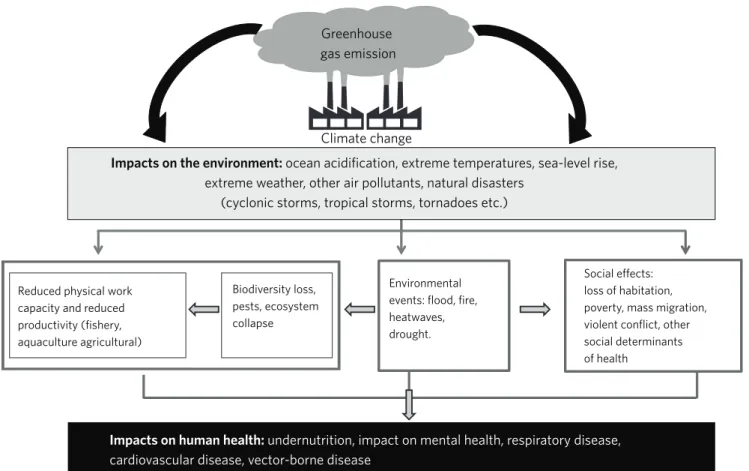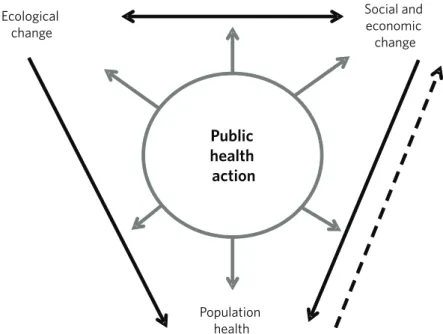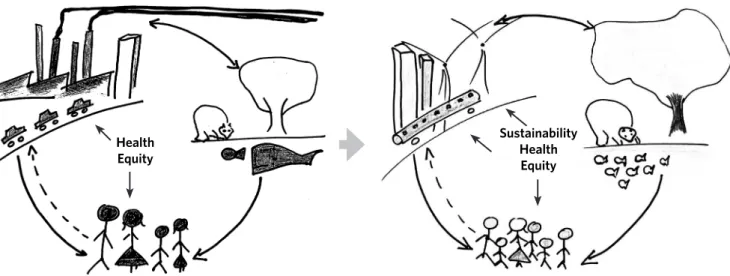ABSTRACT The way in which we have structured our societies has made possible major ad-vances in population health. However, this model, based on intensive exploitation of natural resources, is now the source of the greatest threats to human health. Today’s environmental issues call for bringing to public health an ecological approach whose actions address not only population health, but also ecological, social, and economic changes — i.e., an ecosocial approach to health. Here we examine the implications, for public health action, of adopting such an approach.
KEYWORDS Ecological impact. Public health. Sustainable development indicators.
RESUMO O modo como nossas sociedades foram estruturadas nos permitiu ganhos notáveis em termos de saúde das populações. Contudo, este se baseia em um modelo alicerçado na exploração intensa dos recursos naturais e que é hoje a fonte de uma das maiores ameaças à saúde humana. As questões ambientais atuais clamam pelo investimento de uma abordagem ecológica em saúde pública cuja ação abrange tanto a saúde das populações quanto as mudanças ecológicas, sociais e econômicas, em outras palavras, uma abordagem ecossocial da saúde. Nós veremos neste artigo as implicações da adoção de uma tal abordagem sobre ações em saúde pública.
PALAVRAS-CHAVE Impacto ecológico. Saúde pública. Indicadores de desenvolvimento sustentável.
Public health for a sustainable future: the
need for an engaged ecosocial approach
Saúde pública por um futuro sustentável: a necessidade de uma
abordagem ecossocial comprometida
Astrid Brousselle1, Samantha Gontijo Guerra2
1 University of Sherbrooke, Faculty of Medicine and Health Sciences, Department of Community Health Sciences, Charles-LeMoyne Hospital Research Centre - Longueuil (QC), Canada.
astrid.brousselle@ usherbrooke.ca
2 University of Sherbrooke, Faculty of Medicine and Health Sciences, Department of Community Health Sciences, Charles-LeMoyne Hospital Research Centre – Longueuil (QC), Canada.
Introduction
The way in which we have structured our so-cieties has made possible major advances for the human species: in the past half-century, the global population has more than doubled (UNITED NATIONS, 2015), we have gained 20 years in life expectancy, the mortality rate for chil-dren under five years has fallen by 70%, from 214 per 1,000 live births to 59, and the total number of people living in extreme poverty has gone down by 0.7 billion, while the total population of poor countries has risen by two billion (WHITMEE ET AL., 2015). However, these gains have been accompanied by intensive ex-ploitation of resources. Indeed, we have seen exponential growth in the use of energy and water and increasing use of fertilizers, among other things (WHITMEE ET AL., 2015). We are creat-ing unprecedented pressure on resources: we have reached maximum thresholds for fish stock replenishment, we are seeing a growing loss of forest cover, and water shortages are in-creasingly common (WHITMEE ET AL., 2015). Carbon dioxide emissions are steadily increasing, and oceans are acidifying. Greenhouse gas concentrations are at their highest level in 800,000 years (WHITMEE ET AL., 2015).
Earth is a large ecosystem made up of oxygen, water, plants, and animals, including the human species. The ecological equilib-rium reached among these different elements and species is, today, the primary determinant of human health (NEIRA, 2014; WATTS ET AL., 2015).
The organizational model we have fa-voured, based on development and econom-ic growth, worked well up to a certain point. However, we did not realize the damage it would wreak on our ecosystem, damage exacerbated by the pressure of a growing population in a closed system. Our human actions have been very effective in advanc-ing growth in sectors such as agriculture, fishing, and natural resources extraction, and might be considered successful accord-ing to criteria for productivity, effective-ness, and efficiency, and to have contributed
greatly to population health, but ultimately these actions are not sustainable. We have reached the point where the non-sustain-ability (FITOUSSI, 2013) of our actions is becom-ing the greatest threat to human health. We are now at a decisive threshold for survival of the human species: either we continue with the same model of development and growth, from which we can expect major negative impacts on the environment (e.g. drought, climatic events, fires, floods), on social peace (e.g. rise in mass migrations, habitat loss, violent conflicts) and ultimately, on human health (WATTS ET AL., 2015), or we need to drasti-cally change how we organize our societies.
The four approaches to
public health
structures and biology, from which it follows that, to have a positive impact on health, in-equities must be reduced.
Each of these approaches has, at a given time, dominated public health discourse, and all four continue to co-exist in the con-ception of public health action. There is, however, a fifth model, still in the emergent phase — the ecological public health model (LANG; RAYNER, 2015). According to this approach, human existence cannot be dissociated from planetary and biological dynamics, and to have an impact on public health we need to accept, understand, and influence the eco-logical relationships between humans and the natural environment, which is made up not only of resources, but of living enti-ties. This is the approach we must strive to develop today to confront the challenges imposed by economic growth and the non-sustainability of our human activity.
The ecosocial approach, an
ecological model
To understand the pathways that public health action will have to map out, let
us take the example of global warming. According to the Lancet/Rockefeller Commission on Health and Climate Change, climate change represents the greatest threat to human health (WATTS ET AL., 2015). WHO’s Director responsible for health and the environment has under-scored the fact that climate variations have ecological effects on “the air we breathe, the food we eat and the water we drink,” and that “we are losing our capacity to sustain human life in good health” (NEIRA, 2014). Watts et al.(2015), in their exhaustive article on climate change, describe the consequences with regard to the environ-ment (climatic events, fish stocks, agri-culture) and pollution, and the impacts of these changes on threats to human health. They also highlight the social impacts of these changes as mediators of health (mi-grations, violent conflicts etc.) ( figure 1).
Figure 1. Impact of greenhouse gases on the environment and on human health
This figure shows how a human activity — in this case an industry having nothing to do with health — through its emissions pro-duces environmental and social effects that ultimately affect population health. This accumulation of greenhouse gases is now so great that it is becoming a major deter-mining factor in individual and population health, to such an extent that, according to the report of the Commission on Health and Climate Change, it threatens to obliter-ate all the gains made in global health and development over the past 50 years (WATTS
ET AL., 2015).
This new equilibrium — or rather, disequi-librium — requires us to fundamental rethink
how we see public health. Public health action must be designed in such a way that it influences the most basic determinants of health — in our case, human activity and its interactions with the environment. While it should, of course, act directly on population health, it should also play a role in social and economic changes and help modify ecologi-cal equilibriums in ways that foster a health-supportive equilibrium. According to this ecosocial approach to health (OSTROM, 2009; LIU
ET AL., 2007), public health action is positioned at the intersection of three entities ( figure 2): population health, ecological change, and
social and economic change (CANADIAN PUBLIC HEALTH ASSOCIATION, 2015).
Reduced physical work capacity and reduced productivity (fishery, aquaculture agricultural)
Biodiversity loss, pests, ecosystem collapse
Impacts on human health: undernutrition, impact on mental health, respiratory disease, cardiovascular disease, vector-borne disease
Climate change Greenhouse gas emission
Social effects: loss of habitation, poverty, mass migration, violent conflict, other social determinants of health
Environmental events: flood, fire, heatwaves, drought.
Impacts on the environment: ocean acidification, extreme temperatures, sea-level rise, extreme weather, other air pollutants, natural disasters
(cyclonic storms, tropical storms, tornadoes etc.)
Public health action needs to be fundamen-tally reassessed, such that population health is understood as being primarily determined by sectors of human activity (agriculture, fishing, transportation, use of natural resources etc.). Its means must also be rethought to foster the social changes needed to implement more sustainable solutions, in order to achieve an ecological equilibrium that will support life for humans and other species in the long term. This is a fundamental change in how public health action should be envisioned, which in-volves re-investing in sectors that were histori-cally central to this action but that, over time, have been abandoned for a more individual-oriented approach.
The implications of an
ecosocial approach for
public health action
Adopting an ecosocial approach to public health is a call to fundamentally rethink our
way of seeing public health. First, we need to introduce a new value into our discourse. While public health has, for years, militated in favour of health and equity, it must now also take on the sustainability of human actions, and this, in every sphere of human activity, not just those directly targeting health. Sustainability being the primary determinant of human sur-vival and of population health, this must be the prime criterion for public health action when setting priorities, designing interventions, and evaluating those interventions. Introducing this criterion could have consequences on already existing public health programs. Take, for example, Canada’s Food Guide. Incorporating the sustainability criterion would involve re-vising recommendations on protein sources to limit the impact of human consumption on greenhouse gas production and on fish stocks, among other things (LANG, 2015). This concep-tion of public health also calls for analyzing and evaluating not only the direct impacts of inter-ventions, but also the indirect impacts, which Watts et al.(2015) call the co-benefits.
Second, public health action must be Source: CANADIAN PUBLIC HEALTH ASSOCIATION, 2015, p. 2.
Figure 2. An ecosocial framework for public health action
Public health action
Social and economic change Ecological
change
extended to sectors that do not directly concern health but that can have indirect impacts on health. This means we need to become in-volved in sectors such as transportation, urban planning, manufacturing, energy consumption etc. Moreover, our action must not be limited to assessing the health impacts of public poli-cies, but must also extend to intervening in the private sector of social and economic activity. We need to fundamentally rethink our ways of acting, of organizing, of producing, of con-suming, of transporting ourselves, of commu-nicating etc. This all comes down to imagining better actions, which is, in truth, an ambitious agenda. It is also an agenda that involves re-dressing the power balances in our society and challenging certain powers gained at others’ expense, which is also not an easy thing to do. As some influential groups stand to lose in this restructuring of human activity, the context becomes polarized between those who favour the changes, seeing them as necessary and in-evitable, and those who want to maintain the status quo. This polarization will also have con-sequences for the role to be adopted by public health, which leads us to our third point.
Third, for public health to have a significant
influence on transforming the organization of our societies, we need to raise the awareness of actors who are able to play a strategic role in influencing governments, and we must mobi-lize them to action. The programmatic agenda of an ecosocial approach to public health in-volves disrupting some balances of power. We know, however, that collaborative-participative approaches have only limited influence in po-larized contexts (CONTANDRIOPOULOS ET AL., 2010; CONTANDRIOPOULOS; BROUSSELLE, 2012). As such, if we wish to help shape policies we will need to adopt an ‘advocate’ role, either alone or in strategic groups, to be able to influence govern-ments (ZAHARIADI, 2014; JENKINS-SMITH ET AL., 2014).
At a time when the human race, through its activities and its influence on the environment, is building and shaping the elements funda-mental to its own survival — water, air, plants, animal species — and modifying the ecological balance to the point where it becomes a threat to this very survival, the pathway laid out by the ecological model of health comes down to adopting an engaged ecosocial approach to public health. Figure 3 summarizes the shift
that is needed to move towards an engaged public health approach.
Figure 3. Towards an engaged ecosocial public health
Health Equity
Conclusions
If we remain content to simply improve on what we are already doing, we are in grave danger of missing the mark. Our ways of working in public health up to now have been inadequate to protect the human species from these ecological changes. We therefore have no choice but to change how we do things. In particular, we need to change how we discern future public health priorities. We can no longer prioritize our actions based on past trends. In fact, we must do quite the opposite, and proac-tively anticipate action priorities. We need to imagine other ways of organizing our
societies and of structuring human activity and our cities, and of shaping behaviours. This is, admittedly, an enormous chal-lenge. It will require that we give up certain deeply-ingrained ways of working. We are indeed proposing an ambitious agenda that overturns our traditional conceptions of public health. We can see these new roles as being risky or, at the very least, unsettling. However, today’s issues of non-sustain-ability directly threaten the survival of the human species. We must imagine the world differently, and take the risk of doing things differently — a risk that will still be much less than that of doing nothing by continu-ing along our current path. s
Referências
CANADIAN PUBLIC HEALTH ASSOCIATION. Global change and public health: addressing the eco-logical determinants of health. Discussion document. [Internet]. Ottawa, 2015. Available in: <http://www. cpha.ca/uploads/policy/edh-discussion_e.pdf>. Accessed in: 31 jul. 2015
CONTANDRIOPOULOS, D. et al. Knowledge exchange processes in organizations and policy arenas: a narrati-ve systematic review of the literature. Milbank Q, New York, v. 88, n. 4, p. 444-483, dec. 2010.
CONTANDRIOPOULOS, D.; BROUSSELLE, A. Evaluation models and evaluation use. Evaluation (Lond), London, v. 18, n. 1, p. 61-77, jan. 2012.
EVANS, R. G.; BARER, M. L.; MARMOT, T. R. Why are some people healthy and others not? Hawthorne, NY: Aldine de Guyter, 1994.
FITOUSSI, J. P. Le théorème du lampadaire. Paris: Édition Les Liens Qui Libèrent, 2013.
JENKINS-SMITH, H. et al. The advocacy coalition framework: foundations, evolution and ongoing re-search. In: SABATIER, P. A; WEIBLE, C. M. (Org.). Theories of the policy process. Boulder, CO: Westview Press, 2014. p. 183-224.
LANG, T. Sustainable food, nutrition and health. In: EUROPEAN PUBLIC HEALTH ASSOCIATION CONFERENCE. Plenary presentation. Milan, 2015. Available in: <https://ephconference.eu/plenary-ses-sion-8>. Accessed in: 13 apr. 2016.
LIU, J. et al. Complexity of coupled human and natural systems, Science, New York, v. 317, n. 5844, p. 1513-1516, sep. 2007.
NAVARRO, V. et al. Politics and health outcomes. The Lancet, Londres, v. 368, n. 9540, p. 1033-1037, sep. 2006.
NEIRA, M. Climate change: an opportunity for public health, commentary. Media Center. World Health Organization, 2014. Available in: <http://www.who. int/mediacentre/commentaries/climate-change/en/>. Accessed in: 31 jul. 2015.
OSTROM, E. A general framework for analyzing sus-tainability of social-ecological systems. Science, New York, v. 325, n. 5939, p. 419-422, jul. 2009.
UNITED NATIONS. Department of economic and social affairs. Population division: world population
prospects, the 2015 revision, 2015. Available in: <http:// esa.un.org/unpd/wpp/>. Accessed in: 1 dez. 2015.
WATTS, N. et al. Health and climate change: policy responses to protect public health. The Lancet, London, v. 386, n. 10006, p. 1861-1914, jun. 2015.
WHITMEE, S. et al. Safeguarding human health in the Anthropocene epoch: report of The Rockefeller Foundation-Lancet Commission on planetary health. The Lancet, London, v. 386, n. 10007, p. 1973-2028, jul. 2015.


